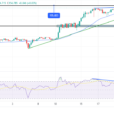
After a campaign fraught with hyperbole and dominated by fearmongering, the dire warnings about the implications of a UK exit from the European Union pushed by the “Remain” camp still have still not come to fruition. Aside from the initial shock in the Pound following the referendum vote, the UK remains business as normal. As the latest data from services, manufacturing, and even inflation show, the warnings about a potential economic collapse were severely over-exaggerated as the UK economy continues to chug along. While difficult to argue, the massive depreciation in the UK Pound actually turned out to be a net positive from many perspectives as the administration under the stewardship of Prime Minister Theresa May prepares the country to exit the European Union with the triggering of Article 50.
Crisis Averted
As recent data suggests, the UK economy remains in a state of stasis despite the risks of companies moving their operations out of the UK. As exit negotiations pick up steam, many EU countries have gone as far as warning the UK that they will not be able to benefit from certain rules while choosing to ignore others, namely freedom of movement. However, when it comes down to it, this factor was one of the primary items the “leave” campaign categorically rejected. While the UK wants to maintain a strong trade relationship with the single-market, it has angered regional peers in its push for increased sovereignty and border control. There is no denying that the UK may still be subject to a near-term dislocation as companies determine the viability of remaining in the UK, however, the gains in trade competitiveness are already evident thanks to the rapid GBPUSD depreciation.
Since falling nearly -15.00% after the decision, the GBPUSD pair has rebounded dramatically back to the upside on the heels of a bounce in economic activity. According to the latest figures, trade has been one of the biggest beneficiaries of the decision to exit, with exports climbing 1.90% during the month of July versus June. Most of the gains were surprisingly the result of increased trade with the EU, which rose by 9.10% during the same period. Aside from improved exports, recent inflation data points to continued improvements in underlying fundamentals. Consumer price data released earlier in the session saw annualized headline inflation remain steady at 0.60%, matching a 20-month reached back in July while rising by 0.30% on a monthly basis. Producer prices also benefited, with headline PPI rising to 0.80%, the fastest pace of producer inflation since early 2014 after nearly two years of deflationary territory.












Leave A Comment